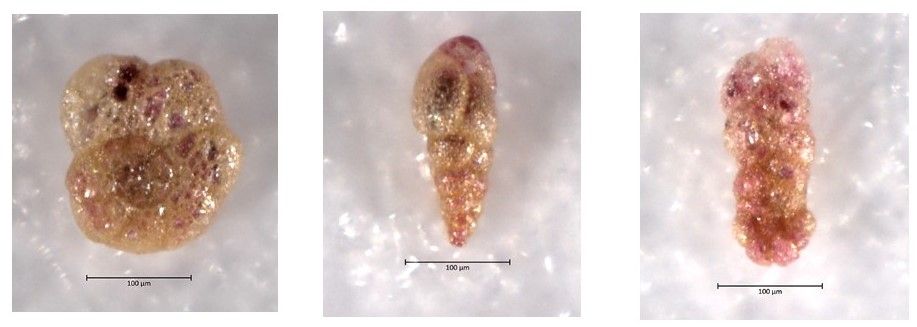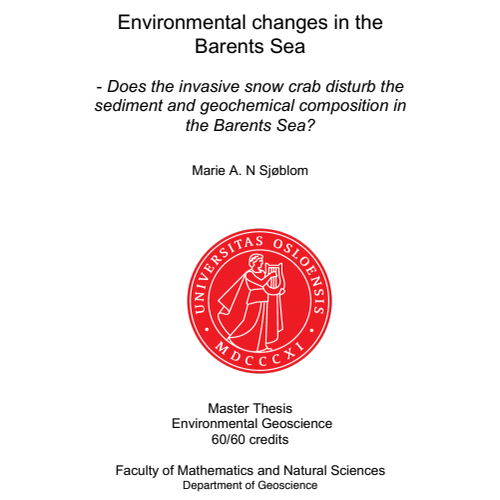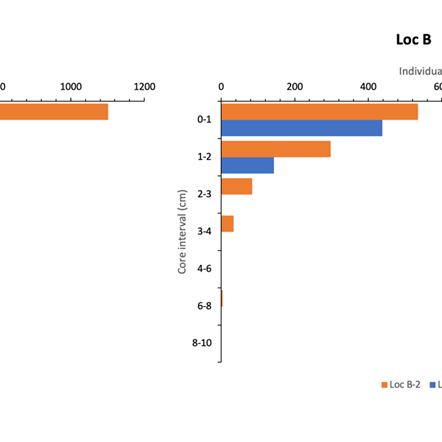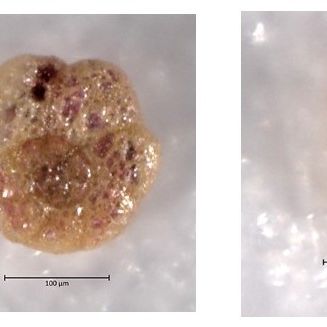28 September 2021 news
Marie Sjøblom defended her thesis on foraminifera in Barents Sea soft-bottom sediments in relation to the invasive snow crab, Chionoecetes opilio, on September 14, 2021 at Department of Geosciences, University of Oslo. Her supervisor was Prof. Elisabeth Alve at UiO. The study was carried out within the frame of the RCN-funded project EISA run by NIVA and Akvaplan-niva. The process addresses effects on structure and function of the benthic ecosystem in the Barents Sea caused by the invasive snow crab.
Foraminifera are single celled mostly small (< 1 mm) organisms found in all marine environments. They construct a test made of calcium carbonate or fine-grained particles glued together. The majority of species lives on or within seafloor sediments. Main factors determining distribution within sediments are oxygen conditions and food availability (organic carbon), that depend on environmental factors such as sediment reworking and mixing from larger-sized benthic organisms, sediment mineral particle composition, and supply of organic material to the seabed. The snow crab may influence the environment of the foraminifera by preying on larger-sized benthic animals, e.g. bristle worms, bivalves and brittle stars, which are important for sediment mixing. The removal of larger-sized organisms may then lead to reduced sediment reworking and in turn to deteriorated microhabitat conditions for sediment-inhabiting organisms. In the present study core samples from 0-10 cm sediment depth collected during EISA cruise in August 2019 (Fig. 1) were analysed for foraminifera, sediment grain sizes and carbon content.

Fig 1. Left: The Gemini gravity corer for sampling of sediments. Middle: Retrieval of core sample within plexiglas tube, typically short sediment plug and clear overlying water. Right: core sample ready for sectioning, about 15 cm deep. Note change from brown fluffy sediments at top to more grey compact sediments downcore. Tubes of bristle worms emerging from the sediment surface and borrows and holes from faunal activity within the sediments are visible. (Photo: Christian Skauge/EISA project).
The samples were taken from two locations in the central Barents Sea with high density of snow crabs (loc A) and low densities of snow crabs (loc B), respectively. The cores were sectioned into 1 or 2 cm intervals to assess vertical distribution of foraminifera and gradients in sediment structure, organic carbon and water content. Three of the recorded species are shown in figure 2. A total of 46 species of foraminifera was recorded, from which six species were selected for detailed analysis of vertical distribution. Most foraminifera were found in the top 1-2 cm sediment level, but some species increased at deeper sediment levels, particularly at the high-crab location (Fig. 3).

Figure 2. Agglutinated benthic foraminifera species (rose Bengal stained) present in the surface sediment (0-1cm) at Loc A, st. 9.1. Left to right: Deuteramminasp., Eggerella europea, Spiroplectammina biformis (Photo: Silvia Hess, Dept. of Geosciences, UiO).
The vertical distribution of foraminifera thus indicated ongoing sediment mixing and liveable conditions down into the sediment. The analyses of organic carbon, sediment grain sizes and water content supported the evidence of sediment mixing, but the downcore sediment at the low-crab location was rather fine-grained, sticky and compact, a condition that may have contributed to low abundance of foraminifera at deeper sediment levels. The results are important for the EISA project as part of the project’s focus on ecological impacts of the snow crab. The information on species distributions and microhabitat conditions within the sediments is particularly relevant for presently ongoing studies of communities of larger benthic organisms (macrofauna) and quantification of ecosystem functions with regard to faunal activity, trophic relationships, and sediment reworking.

Figure 3. Distribution of foraminifera in 0-10 cm sediment depth for 1 or 2 cm intervals at high crab density (Loc A) and low crab density (Loc B). Brown and blue columns represent separate core samples. All values are standardised to individuals per 10 cm3 of sediment. (Illustration from thesis, Marie Sjøblom).
University of Oslo, Department of Geosciences: Marie Sjøblom: Environmental changes in the Barents Sea - Does the invasive snow crab disturb the sediment and geochemical composition in the Barents Sea?



